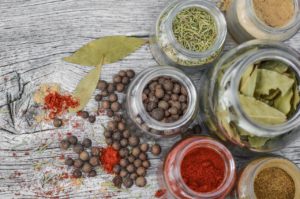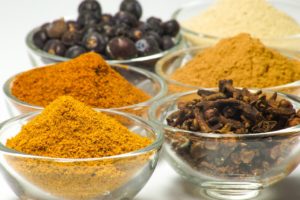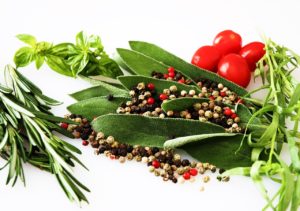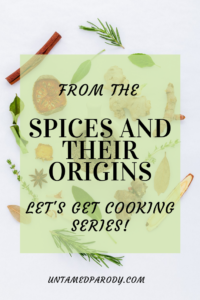
If you know a bit about spices you can make just about anything! In my Let’s Get Cooking series, I’m going to teach you everything you need to know about spices and their origins, and how they’re used, so that you can have super flavorful, restaurant quality meals in no time.
What is a Spice?
A spice can be defined as a seed, root, bark, fruit, or other plant derivative, mainly used for flavoring or preserving food. Herbs are the leaves, flowers, or stems of plants. The two are often referred to together as herbs and spices to be used in recipes in the various cuisines around the world.
A Little Bit of History
Many spices come from warmer climates and have antimicrobial properties, so they can also be used as medicine. Ayurvedic medicine in India dates back more than 5,000 years, and of course, Indian food is famous for its herbs and spices.
Spices were used instead of refrigeration to preserve foods. The ancient Egyptians even used them to preserve mummies. The origins of spice trading can be traced back to around 500 BC, when Chinese and Korean junk boat captains would trade spices. The demand grew as the spices were sold more widely.
The demand for spices in Europe grew after the first crusades in the late 12th and early 13th centuries, with ginger and cinnamon being particular favorites. The famed Marco Polo traveled all the way to China and found far more than spices, but his original goal was to trade in the spices that were in such high demand.
During the Age of Exploration, the Dutch formed the East India Company, which became one of the most powerful trading companies in the world, with a range of exotic ingredients being sourced from the so-called Spice Islands (now Indonesia) and India.
We still use many of the spices Europeans found so wondrous, including:
- Black pepper
- Cinnamon
- Cloves
- Cumin
- Ginger
- Nutmeg and mace (the outer part of the nutmeg)
- Turmeric
- And more!
If you’ve ever eaten a pumpkin pie, you will know the taste of mace. If you’ve ever tried an Indian rice dish, you will know the taste of turmeric and often cumin as well.
Spices and their Origins
Some of our modern ingredients actually have quite the history. Basil, a common ingredient in Italian food and what makes pesto sauce green actually came from India and Persia (modern-day Iran). It was a favorite seasoning of the ancient Romans and continues to this day as a mainstay of Italian cooking.
Bay leaves come from laurel trees from the Middle East. Use them whole to season soups and stews, but they’re not to be eaten. Be sure to remove them before serving so no one gets an upset stomach.
Cardamom has been used as a medicine since the 4th century BC. Romans and Greeks used it to aid digestion. In Sweden, it is even more popular than cinnamon in baked goods. It has a delicious, warm flavor.
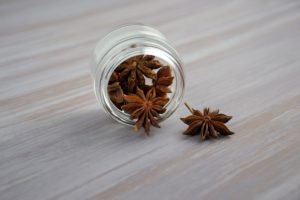
Beautiful star anise
Cinnamon comes from the dried bark of several different types of laurel trees. Didn’t realize you were eating bark, did you? It comes from Sri Lanka (formerly known as Ceylon) and was imported by the ancient Egyptians via China as early as 2000 BC. Cinnamon was scarce to the Romans, who would burn it as incense during funerals. The high demand for cinnamon in the West helped trigger colonial expansion as Columbus and others searched for a shorter route to the Far East and all the riches to be found there — not just gold and silver, but also the incredibly rare and valuable spices.
Star anise is a dried flower which has a wonderful licorice flavor, but a bitter aftertaste, making it perfect for savory cooking. It is one of the spices in Chinese five-spice blends. It’s truly a beautiful spice to see, too.
Spices in the Modern World
It is hard to imagine that wars have been fought over spices and that they were once more valuable than gold, when all we have to do is go to a supermarket or online to buy them. But the reasons they were so treasured still remain valid: for seasoning, color, flavoring, food preservation, and healing.
The Series
This series will feature NINE more pieces on cooking with spices, including essentials every kitchen should have.I’m also wrapping up my FREE Ebook which will be available soon. If you’d like information about my Ebook, drop me a comment below or via the Contact button up top. And finally, be sure to subscribe to my weekly updates so you don’t miss a thing. Head way up top or over to the right lane for my subscribe form!
In the meantime, this is the spice rack I have in my own kitchen and I just love it. What’s really cool is this particular one offers FIVE years of free refills! I love that it doesn’t take up a lot of space on my countertop. They also have great 12- or 16-jar options, too! And, if you find there’s a particular included spice you don’t use a lot you can always relabel and reuse the jars!
Related Posts
